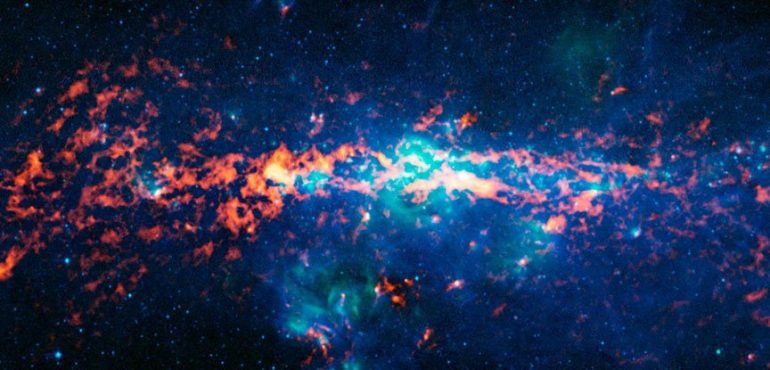The molecule in question, propylene oxide, was discovered in a gigantic gas cloud called Sagittarius B2, located about 390 light-years from the centre of the Milky Way. Sagittarius B2 has a mass around 3 million times the mass of the Sun, and now we know that this huge conglomeration contains chiral molecules in its midst, which had never previously been detected outside our Solar System.
"This is the first molecule detected in interstellar space that has the property of chirality, making it a pioneering leap forward in our understanding of how prebiotic molecules are made in the Universe and the effects they may have on the origins of life," said chemist Brett McGuire from the National Radio Astronomy Observatory in Virginia.
Chirality is a geometric property of molecules, where asymmetric molecules display an almost identical chemical composition, but in an altered configuration – much like a mirror image – in what are called left-handed or right-handed versions.
It's a key chemical property of life on Earth, where every molecule that helps to form living things – such as amino acids, proteins, enzymes, and sugars – appears in only the left- or right-handed version of itself. This is called homochirality, and while it gives a biological benefit – as the matching molecules can fit better with one another to make larger organic structures – nobody knows how this 'chiral bias' came about.
"Propylene oxide is among the most complex and structurally intricate molecules detected so far in space," said one of the researchers, Brandon Carroll from the California Institute of Technology in Pasadena. "Detecting this molecule opens the door for further experiments determining how and where molecular handedness emerges, and why one form may be slightly more abundant than the other."
The researchers identified the molecular signature of propylene oxide using the Green Bank Telescope (GBT) in West Virginia, with supporting observations coming from the CSIRO's Parkes radio telescope in Australia.
The team thinks complex molecules like this could form in the gas cloud from thin mantles of ice that develop on extremely tiny dust grains floating in space. These ice mantles would enable the molecules to form larger molecular structures, and help produce other chemical reactions within the cloud should the ice evaporate.
It sounds like a glacial process, but the fact that chiral molecules are doing this at all in deep space could help explain how they later make their way onto asteroids and comets – which might end up seeding the molecules on the surface of planets in the event of an impact.
The two 'handed' versions of propylene oxide. Credit: B. Saxton, NRAO/AUI/NSF from data provided by N.E. Kassim, Naval Research Laboratory, Sloan Digital Sky Survey
"Meteorites in our Solar System contain chiral molecules that predate Earth itself, and chiral molecules have recently been discovered in comets," said Carroll. "Such small bodies may be what pushed life to the handedness we see today."
In other words, these molecules – and the chance we now have to study them in isolation – could tell us a lot about where life comes from and how it evolves the way it does, including why it's so choosey about being a lefty or a righty.
"By discovering a chiral molecule in space, we finally have a way to study where and how these molecules form before they find their way into meteorites and comets," said McGuire, "and to understand the role they play in the origins of homochirality and life."
Source: Science Alert, http://www.sciencealert.com/scientists-just-detected-this-life-forming-molecule-in-interstellar-space-for-the-first-time


